 Vitamin E, Heart Disease and Tocotrienols by Jeffrey Dach MD
Vitamin E, Heart Disease and Tocotrienols by Jeffrey Dach MDThis article is part two of a series, for part one, click here.
About 15 years ago, we took a family rafting vacation on the Snake River in Idaho (see image below). Everyone survived the river adventure, and we later explored Coeur D’Alene where I stumbled upon a dusty second hand book store called the “Book Worm”. Inside, I found a 1964 copy of “Vitamin E, Your Key to a Healthy Heart” by Herbert Baily. I later learned this book sold a million copies and stimulated considerable interest in Vitamin E. It was one of the first books to make vitamins popular.
Snake River in Idaho Courtesy of Wikimedia Commons
About 86 years ago, an obscure researcher named Herbert McLean Evans, was hot on the trail of an unknown dietary ingredient in wheat germ required for fertility in his laboratory rats. This was Vitamin E. The chemical structure was determined in 1938, and Evans named it from the Greek words,”tocopherol”, meaning “to bear young”.
In the 1930’s and 1940’s, two Canadian cardiologists, Wilfred and Evan Shute treated 30,000 patients with natural vitamin E and reported considerable success in reversing heart disease.
In 2008, I attended the ACAM Medical Meeting in Orlando where Kenny Jialal, MD was presented the Linus Pauling Award in recognition of his Vitamin E research. Dr. Jialal then took the podium and spoke on Vitamin E, summarizing hundreds of research studies over decades. Some studies were favorable, some were unfavorable, some used one type of vitamin E, some used another type of vitamin E, some he had no idea which type was used. I think you get the gist. At the end of the hour, Dr Jialal had completely confused any remaining understanding of Vitamin E, transforming the topic into a giant enigma wrapped in a mystery.
 New Insights and Clarifications
New Insights and Clarifications
In this article, we will hopefully remedy any confusion about Vitamin E with new insights. First, let’s look at some recent doubts about Vitamin E.
Left Image: Courtesy Orange Torpedo River Rafting on the Snake River, Idaho.
You may have seen news reports that Vitamin E is dangerous, deadly and increases mortality. These media stories were based on an article by Edgar Miller in the Jan 2005 Annals of Internal Medicine, a meta-analysis of 19 studies on Vitamin E, concluding that Vitamin E increases mortality. Here are a few of the news reports:
High dose vitamin E death warning Thursday, 11 November, 2004, BBC News. High doses can be harmful. Elderly people could be risking their lives if they take even moderately high doses of vitamin E, evidence suggests.
Study: High dose of Vitamin E increases death risk. By Steve Sternberg, USA TODAY 11/10/2004 High-dose vitamin E supplements taken daily can increase a person’s risk of premature death, researchers said Wednesday. People who take daily doses of 400 international units or higher are about 10% more likely to die of a variety of causes than people who take smaller doses or no vitamin E, according to an analysis of 14 studies conducted between 1993 and 2004. Many of the studies did not specify causes of death, but researchers believe patients died of all the usual causes, including heart disease and cancer.
The effect of Miller’s Vitamin E article was that many people stopped Vitamin E. An excellent rebuttal to Miller by Dr Mark Houston pointed out the type of Vitamin E used in Miller’s meta-Analysis was synthetic dl alpha tocopherol. “None of the 19 studies in Miller’s review article included any of the other seven forms of vitamin E, and, in fact, most of them used the synthetic d, l alpha tocopherol form.” It is important to distinguish natural vitamin E from the synthetic Vitamin E which is to be avoided, in addition Houston recommended a mixture of the 8 types of Vitamin E found in nature.
 The Fox Guarding the Henhouse?
The Fox Guarding the Henhouse?Amazingly,another negative Vitamin E study published by Sesso in JAMA Nov 9, 2008 again used the synthetic form of Vitamin E.(9) You would think that doctors in general, being highly intelligent, would know to use the natural form of vitamin E. A skeptic might suggest that perhaps the synthetic form was intentionally used to insure failure and discredit vitamin E.
Left Image Fox Courtesy Wikimedia
 Another disturbing fact is that Sesso’s negative Vitamin study was sponsored by Wyeth, a drug company with a long history of animosity to natural treatments. The paper also disclosed that the authors were in bed with the drug companies. They received funding from Wyeth, Merck, Bristol Meyer Squibb, Astra Zeneca, Pfizer and Bayer. Gaziano, the chair of the project, even served as expert witness for Merck, defending the drug company in court.(9) I would say this is another example of the fox guarding the henhouse.(10)
Another disturbing fact is that Sesso’s negative Vitamin study was sponsored by Wyeth, a drug company with a long history of animosity to natural treatments. The paper also disclosed that the authors were in bed with the drug companies. They received funding from Wyeth, Merck, Bristol Meyer Squibb, Astra Zeneca, Pfizer and Bayer. Gaziano, the chair of the project, even served as expert witness for Merck, defending the drug company in court.(9) I would say this is another example of the fox guarding the henhouse.(10)
Left Image Henhouse courtesy wikimedia
Natural vitamin E is in the “D” form (meaning Dextro which is Latin for Right-Handed). Synthetic Vitamin E is a combination of D and L form (ie DL). The synthetic form is cheaper, but is not recommended. There are the 8 types of tocopherols in natures including, alpha, delta, gamma forms. Jialal says the gamma form is more beneficial than the alpha form.
Two landmark Vitamin E studies were published in 1993 in the New England Journal of Medicine. Rimm’s study showed a 36% reduction in heart disease in men taking the relatively modest 60 IU vitamin E daily in the diet. Meir Stamfer’s study showed a 33% reduction in heart attacks in women with the highest dietary vitamin E consumption.
In 1992, Verlanger published a study in which natural vitamin E reversed atherosclerosis in a primate model.
A 1995 study published in JAMA by Hodis showed Vitamin E caused regression of atherosclerosis on serial coronary angiography. Hodis concluded. “These results indicate an association between supplementary vitamin E intake and angiographically demonstrated reduction in coronary artery lesion progression.”
In 1996, Stephens published his study in Lancet which showed that tocopherol (vitamin E ) given to patients with advanced coronary artery disease reduced the risk of non-fatal MI by 77%, (but did not decrease total mortality in this study).
In 2000, Boaz published a study in Lancet showing that 800 IU/daily of natural Vitamin E reduced heart attacks by 70% over 1.4 years in Hemodialysis patients.
 In 1997, Kooyenga and Bierenbaum presented their data on reversal of atherosclerosis in carotid stenosis with mixed tocopherols and tocotrienols at a meeting in Montreal.
In 1997, Kooyenga and Bierenbaum presented their data on reversal of atherosclerosis in carotid stenosis with mixed tocopherols and tocotrienols at a meeting in Montreal.
Left Image : Carotid Angiogram showing severe ulcerated stenosis at origin of internal carotid artery. Courtesy Jeffrey Dach MD.
The Bierenbaum study was done at the Kenneth Jordan Heart Research Foundation in New Jersey. The five-year study evaluated 50 patients who had stenosis of the carotid artery. One group of 25 patients received 650 mgs of tocotrienols plus tocopherols. The other group of 25 received a placebo. All patients had serial carotid sonography every six months. In the Placebo group, fifteen patients showed worsening of the stenosis, eight remained stable and two showed some improvement. In the Tocotrienol (plus tocopherol) group, three patients showed minor worsening, and 12 remained stable. 10 patients showed regression of stenosis with improvement.
Not only is there a difference between synthetic and natural vitamin E, there is also a new form of vitamin E called Tocotrienol which new research suggests is the more biologically useful form. Let’s take a look at the Tocotrienol form of Vitamin E:
The Difference Between the Tocopherol and Tocotrienol Forms
Tocopherol – Straight Tail

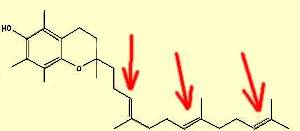 Tocotrienol -Curved Tail
Tocotrienol -Curved Tail
Notice that Tocotrienol is IDENTICAL to Tocopherol except for the three double bonds (red arrows). These three double bonds create a kinked configuration of the “tail” which allows the molecule more mobility through lipid membranes. The double bond also indicates a state of electron desaturation, meaning it can accept electrons readily as an antioxidant. The three double bonds represents an “unsaturated” side chain which allows the molecule to penetrate into saturated lipid membrane layers in various target organs. Thus, the tocotrienol form is superior to tocopherol as an antioxidant, serving to reverse lipid peroxidation.
About 99% of medical research since the discovery of Vitamin E has been devoted to the tocopherol form, and 1% on the tocotrienol form. This seems to be changing.
There are no synthetic forms of tocotrienols available, only natural ones.
Remember the difference between Processed Trans-Fats and Natural Oils such as cold pressed olive oil? The unhealthy Trans Fats have a straight carbon tail because they have been processed, so the Carbons are located on the opposite sides of the double bonds (trans). The healthy natural oils have a curved configuration of the carbon tail because the Carbons are on the same side of the double bond (cis). (see below) This difference is called cis-trans isomerism.
Toxic Trans Fats -Straight
 Left Image: Straight Carbon Tail.
Left Image: Straight Carbon Tail.
Elaidic acid is a trans unsaturated fatty acid often found in partially hydrogenated vegetable oils a Toxic Trans Fat. Courtesy Wikipedia.
Healthy Natural Cold Processed Olive Oil – Curved
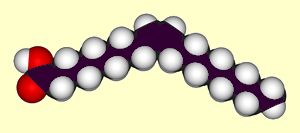 Left Image: Curved Carbon Tail.
Left Image: Curved Carbon Tail.
Oleic acid is a cis unsaturated fatty acid that comprises 55–80% of cold pressed olive oil. Courtesy Wkipedia.
Extremely Curved Tail: Beneficial Omega 3 Oils
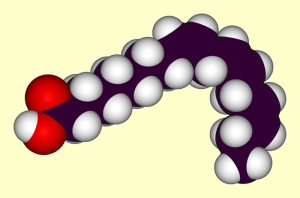 Left Image: is 3D structure of alpha-linolenic acid (ALA) an essential Omega 3 oil. Notice the very bent or curved configuration of the carbon tail. The tail shows more extreme curving than the above example of Olive Oil.
Left Image: is 3D structure of alpha-linolenic acid (ALA) an essential Omega 3 oil. Notice the very bent or curved configuration of the carbon tail. The tail shows more extreme curving than the above example of Olive Oil.
![]()
Above Image: Shows position of the three cis double bonds for alpha-linolenic acid (ALA), an essential n-3 fatty acid, Omega 3 oil. Notice three double bonds at the 3, 6 and 9 positions, (just like Tocotrienol). The carbon tail is bent or kinked because of the double bonds. In general double bonds for natural oils are all in the cis-configuration, while processed oils are in the trans-configuration. Images Courtesy Wikipedia.Tocotrienol
Similar to the above example for the beneficial natural oils, the beneficial tocotrienols have a curved carbon tail, giving it more biological activity than its tocopherol counterpart. Note that the tail is not stationary but actually vibrates back and forth in space like a pendulum, absorbing energy within the membrane bi-layer. Although in the case of Tocotrienols, the three double bonds are in the trans-configuration, this is sufficient to bend the tail configuration significantly (see below).
Schematic of Vitamin E inside the Cell Membrane Bilayer
Tocopherol (below)
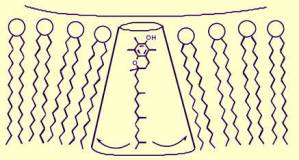 Tocopherol with straight tail, showing less oscillations inside the membrane phospholipid bilayer.
Tocopherol with straight tail, showing less oscillations inside the membrane phospholipid bilayer.
Left Images Courtesy of
Chandan K. Sen
et al Tocotrienols
in Health and Disease
Tocotrienol (below)
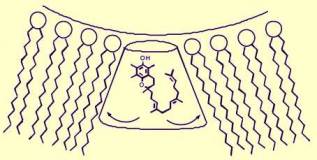 Tocotrienol has curved tail which oscillates back and forth inside the phospholipid membrane bilayer with greater separation.
Tocotrienol has curved tail which oscillates back and forth inside the phospholipid membrane bilayer with greater separation.
Health Benefits of Tocotrienol Form of Vitamin E
1) Tocotrienols are protective in stroke-induced injuries. Natural palm tocotrienol complex fed to hypertensive rats led to increased tocotrienols level in the brain, and more protection against stroke-induced injury compared to controls.
(Stroke Oct 2005).
2) Tocotrienol reversed atherosclerosis in carotid artery stenosis in human study by Bierenbaum. (Watkins TR, Bierenbaum ML, Giampaolo A. Tocotrienols: Biological and Health Effects. In Antioxidant Status, Diet, Nutrition and Health, Papas AM editor, CRC Press, Boca Raton, 1998;479-96)
3) Tocotrienols and cholesterol reduction: Gamma tocotrienol inhibit hepatic cholesterol synthesis without interfering with CoQ10 production, thus reducing LDL cholesterol levels safely. (see interview with Barrie Tan below)
The Apo-E Mouse Model is a genetically modified mouse that develops atherosclerosis of the aorta. Two separate studies, by Qureshi and another by Black showed that feeding Tocotrienols to the Apo-E mice virtually eliminates atherosclerotic plaque. Tocotrienols reduced the atherosclerosis plaqueby by 98%, an amazing result. On the other hand, Tocopherols had no such beneficial effect in Apo-E mice in the study by Shaish (1999) who found no change in plaque size with Tocopherols.
Tocotrienols from Bixa Fruit
 Image left: Fruit of mature Bixa orellana (roucou). Kourou, French Guiana. Source for Tocotrienols:Courtesy of Wikimedia Commons
Image left: Fruit of mature Bixa orellana (roucou). Kourou, French Guiana. Source for Tocotrienols:Courtesy of Wikimedia Commons
Dr. Tocotrienol, Barrie Tan
Barrie Tan discovered a plant in South America called annatto (or bixin) which provides pure tocotrienols. Tan owns the patent on the extraction process.
Here is an interview with Barrie Tan discussing health benefits of Tocotrienols
Part One of Interview with Barrie Tan on Tocotrienols. Part Two of Interview with Barrie Tan on Tocotrienols.
My previous article discussed the use of high dose Vitamin C, and the amino acid, Lysine, (the Linus Pauling Protocol) for reversing heart disease. Steve Hickey and Hilary Roberts come right out on page 167 of their book, and make the statement, “Vitamin C and Tocotrienols can reverse coronary artery disease”. They would improve the Linus Pauling Protocol by adding the Tocotrienol form of Vitamin E. Regarding heart disease, and atherosclerotic vascular disease, the authors state that “on the available evidence, the combination of Vitamin C and Tocotrienols could be curative with no known harmful effects.”
Tocotrienols clearly prevent atherosclerosis in the Apo-E mouse model. Further research in the guinea pig model should be done. Willis showed that Vitamin C deprived guinea pigs develop atherosclerotic vascular disease. Experiments should be done giving tocotrienols to Vitamin C deprived guinea pigs, and I would predict Tocotrienols would be beneficial, reducing or preventing atherosclerotic plaque formation. In addition, there is a GLO deficient mouse model used to study atherosclerosis. Experiments giving tocotrienols to GLO deficient mice should also be done.
The Last Soldier Killed in the Great War
 On November 11, 1918, at exactly 10:59 AM, US soldier Henry Gunther was the last soldier to be killed in action in WWI. Gunther’s death was unnecessary and tragic because the war ended one minute later. Above image courtesy wikimedia: WWI American Soldiers.
On November 11, 1918, at exactly 10:59 AM, US soldier Henry Gunther was the last soldier to be killed in action in WWI. Gunther’s death was unnecessary and tragic because the war ended one minute later. Above image courtesy wikimedia: WWI American Soldiers.
The War on Heart Disease is Over, We Won
Likewise today, to die from heart attack is both unnecessary and tragic. Information is now readily available explaining how heart disease can be prevented and reversed with simple inexpensive nutritional supplements at home. One need only read the information, and the evidence is overwhelming. There is no need for expensive drugs, cath labs or bypass operations. A simple combination of Vitamin C, Lysine, and the Tocotrienol Form of Vitamin E is sufficient to prevent and reverse heart disease. Don’t be like Henry Gunther, the last casualty at the end of the war.
For Part One of this series, see
Heart Disease, Ascorbate, Lysine and Linus Pauling by Jeffrey Dach MD.
Vitamin E – Bleeding Precautions:
Vitamin E can have a blood thinning effect, so most surgeons and anesthesiologists will ask about Vitamin E use prior to elective surgery, and request that the Vitamin E be discontinued a week in advance of elective surgery to avoid bleeding complications.
Where to Buy Tocotrienols:
The Annato form of Vitamin E Tocotrienols are available from the A C Grace Company as well as many other vitamin companies on the internet. Other forms include: Tocovid Suprabio, and Tocomin (Carotech, NJ).
What is the Linus Pauling Protocol?
L-ascorbate (Vitamin C) 5-6 grams a day in divided doses
L-Lysine 5 grams a day in divided doses
L-Proline 2-3 grams a day in divided doses
These supplements can be obtained at any the health food store as tablets or capsules for 40 to 50 dollars a month. A convenient powder form can be obtained at Tower Laboratories. They have a product called Heart-Tech which provides the Linus Pauling Protocol in powder form. There is also the Vitamin C Foundation Cardio-C which provides 2500 mg vitamin C and 2500 mg lysine per serving plus 500 mg proline. (link).
Related articles:
Saving Time Russert and George Carlin
Healthy Men Should Not Take Statin Drugs
Heart Disease Vitamin C and Linus Pauling
Getting Off Statin Drug Stories
How to Reverse Heart Disease with the Coronary Calcium Score (part one)
Reversing Heart Disease Part Three
Cholesterol Lowering Drugs for the Elderly, Bad Idea
Cholesterol Lowering Statin Drugs for Women Just Say No
Jeffrey Dach MD
www.jeffreydach.com
www.drdach.com
www.naturalmedicine101.com
www.truemedmd.com
References
(1) http://news.bbc.co.uk/1/hi/health/3998847.stm
High dose vitamin E death warning Thursday, 11 November, 2004, 00:09 GMT
High doses can be harmful. Elderly people could be risking their lives if they take even moderately high doses of vitamin E, evidence suggests.
(2)
http://www.usatoday.com/news/health/2004-11-10-vitamin-e-risks_x.htm
Study: High dose of Vitamin E increases death risk
By Steve Sternberg, USA TODAY 11/10/2004 6:50 PM
(3) http://www.ucdmc.ucdavis.edu/ucdavismedicine/issues/fall2008/
departments/honors_and_awards.html
The American College for Advancement in Medicine has presented internal medicine researcher Ishwarlal Jialal with the Linus Pauling Award for notable achievement in the field of integrative medicine. Jialal, who is the Robert E. Stowell Endowed Chair in Experimental Pathology and director of the Laboratory for Atherosclerosis and Metabolic Research, was specifically recognized for his extensive and groundbreaking research with vitamin E and vascular disease. In addition, Jialal investigates cardiovascular pathology, lipoprotein metabolism, free-radical biology and mechanisms of antioxidant actions as they relate to atherosclerosis.
(4)
http://www.ucdmc.ucdavis.edu/search/faculty/biodetail.asp?bioid=860
Ishwarlal Jialal, M.D., Ph.D. UC Davis Professor Robert E. Stowell Endowed Chair in Experimental Pathology Director of Laboratory for Atherosclerosis and Metabolic Research Specialty: Pathology and Laboratory Medicine, Biological Chemistry
Doctor Tocotrienol Barrie Tan
(5) Part One
http://www.drpasswater.com/nutrition_library/tan_1.html
(6) Part two
http://www.drpasswater.com/nutrition_library/tan_2.html
July 9, 2008 Dr. Tocotrienol
Here is an interview from Whole Foods Magazine with Dr. Barrie Tan. Dr. Tan is one of the leaders in tocotrienol research if not the leader. He’s been studying the other side of Vitamin E since about 1984. For his work he’s earned the nickname “Dr. Tocotrienol.”
(7) http://www.acgrace.com/images/stories/acgrace/healthbenefitsbeyondvitamineactivity.pdf
(7) Health Benefits Beyond Vitamin E Activity, Solving the Tocotrienol Riddle. An interview with Dr. Barrie Tan
(8) http://www.pubmedcentral.nih.gov/articlerender.fcgi?tool=pubmed&pubmedid=17507086
Mol Aspects Med. 2007; 28(5-6): 692–728.
Tocotrienols in health and disease: the other half of the natural vitamin E family
Chandan K. Sen, Savita Khanna, and Sashwati Roy
Tocochromanols encompass a group of compounds with vitamin E activity essential for human nutrition.
Structurally, natural vitamin E includes eight chemically distinct molecules: a-, ß-, ?- and d-tocopherol; and a-, ß-, ?- and d-tocotrienol. Symptoms caused by a-tocopherol deficiency can be alleviated by tocotrienols.
Thus, tocotrienols may be viewed as being members of the natural vitamin E family not only structurally but also functionally. Palm oil and rice bran oil represent two major nutritional sources of natural tocotrienol.
Taken orally, tocotrienols are bioavailable to all vital organs. The tocotrienol forms of natural vitamin E possesses powerful hypocholesterolemic, anti-cancer and neuroprotective properties that are often not exhibited by tocopherols. Oral tocotrienol protects against stroke-associated brain damage in vivo.
Disappointments with outcomes-based clinical studies testing the efficacy of a-tocopherol need to be handled with caution and prudence recognizing the untapped opportunities offered by the other forms of natural vitamin E.
Although tocotrienols represent half of the natural vitamin E family, work on tocotrienols account for roughly 1% of the total literature on vitamin E. The current state of knowledge warrants strategic investment into investigating the lesser known forms of vitamin E.
Structurally, tocotrienols differ from tocopherols by the presence of three trans double-bonds in the hydrocarbon tail.
Clinical Failure of Vitamin E
(9) http://jama.ama-assn.org/cgi/content/full/300/18/2123
Vitamins E and C in the Prevention of Cardiovascular Disease in Men
The Physicians’ Health Study II Randomized Controlled Trial. Howard D. Sesso et al
JAMA. 2008;300(18):2123-2133. November 9, 2008
Conclusions In this large, long-term trial of male physicians, neither vitamin E nor vitamin C supplementation reduced the risk of major cardiovascular events. These data provide no support for the use of these supplements for the prevention of cardiovascular disease in middle-aged and older men.
(10)http://aahf.nonprofitsoapbox.com/index.php?option=com_content&task=view&id=601&Itemid=
Unfair Attacks on Supplements. The following is an analysis of a recent study on vitamins C and E by the scientific team of the Alliance for Natural Health, our international affiliate. Designed To Fail: A Trial Without Meaning. Contributed by Steve Hickey, Ph.D.; Damien Downing, M.B.B.S.; and Robert Verkerk, Ph.D., Alliance for Natural Health.
Type of E used was Synthetic: vitamin E 400 IU synthetic -tocopherol
http://www.ncbi.nlm.nih.gov/pubmed/16190316
Nutr Rev. 2005 Aug;63(8):290-3.
Failure of vitamin E in clinical trials: is gamma-tocopherol the answer? Devaraj S, Jialal I. Laboratory for Atherosclerosis and Metabolic Research, Department of Pathology and Laboratory Medicine, University of California-Davis Medical Center, Sacramento, USA.
Oxidative stress and inflammation play a crucial role in atherosclerosis. However, prospective clinical trials of dietary antioxidants with anti-inflammatory properties, such as alpha-tocopherol (AT), have not yielded positive results. AT supplementation decreases gamma-tocopherol (GT) levels. GT is an antioxidant with potent anti-inflammatory activity, and plasma GT levels are inversely associated with cardiovascular diseases. Thus, studies using pure GT, alone or in conjunction with AT, will elucidate its utility in cardiovascular disease prevention.
http://www.annals.org/cgi/content/full/142/1/75
EDITORIAL Vitamin E Supplements: Good in Theory, but Is the Theory Good? E. Robert Greenberg, MD Annals of Internal Medicine 4 January 2005 | Volume 142 Issue 1 | Pages 75-76
http://www.annals.org/cgi/content/full/142/1/37
REVIEW Meta-Analysis: High-Dosage Vitamin E Supplementation May Increase All-Cause Mortality
Edgar R. Miller, III, MD, PhD; Roberto Pastor-Barriuso, PhD; Darshan Dalal, MD, MPH; Rudolph A. Riemersma, PhD, FRCPE; Lawrence J. Appel, MD, MPH; and Eliseo Guallar, MD, DrPH
Annals of Internal Medicine 4 January 2005 | Volume 142 Issue 1 | Pages 37-46
Background: Experimental models and observational studies suggest that vitamin E supplementation may prevent cardiovascular disease and cancer. However, several trials of high-dosage vitamin E supplementation showed non–statistically significant increases in total mortality.
Purpose: To perform a meta-analysis of the dose–response relationship between vitamin E supplementation and total mortality by using data from randomized, controlled trials.
Patients: 135 967 participants in 19 clinical trials. Of these trials, 9 tested vitamin E alone and 10 tested vitamin E combined with other vitamins or minerals. The dosages of vitamin E ranged from 16.5 to 2000 IU/d (median, 400 IU/d).
Data Sources: PubMed search from 1966 through August 2004, complemented by a search of the Cochrane Clinical Trials Database and review of citations of published reviews and meta-analyses. No language restrictions were applied.
Data Extraction: 3 investigators independently abstracted study reports. The investigators of the original publications were contacted if required information was not available.
Data Synthesis: 9 of 11 trials testing high-dosage vitamin E (400 IU/d) showed increased risk (risk difference > 0) for all-cause mortality in comparisons of vitamin E versus control. The pooled all-cause mortality risk difference in high-dosage vitamin E trials was 39 per 10 000 persons (95% CI, 3 to 74 per 10 000 persons; P = 0.035). For low-dosage vitamin E trials, the risk difference was –16 per 10 000 persons (CI, –41 to 10 per 10 000 persons; P > 0.2). A dose–response analysis showed a statistically significant relationship between vitamin E dosage and all-cause mortality, with increased risk of dosages greater than 150 IU/d.
Limitations: High-dosage (400 IU/d) trials were often small and were performed in patients with chronic diseases. The generalizability of the findings to healthy adults is uncertain. Precise estimation of the threshold at which risk increases is difficult.
Conclusion: High-dosage (400 IU/d) vitamin E supplements may increase all-cause mortality and should be avoided.
http://www.annals.org/cgi/content/full/142/1/I-40
SUMMARIES FOR PATIENTS Vitamin E Supplements May Be Harmful
Annals of Internal Medicine 4 January 2005 | Volume 142 Issue 1 | Page I-40
Summaries for Patients are a service provided by Annals to help patients better understand the complicated and often mystifying language of modern medicine.
Summaries for Patients are presented for informational purposes only. These summaries are not a substitute for advice from your own medical provider. If you have questions about this material, or need medical advice about your own health or situation, please contact your physician. The summaries may be reproduced for not-for-profit educational purposes only. Any other uses must be approved by the American College of Physicians.
Rebuttal to Miller
http://ana-jana.org/reprints/VitaminEEditorialbyMarkHouston,_MD.pdf
http://www.antiaging.com/white_papers/vitamin_e_jana.html
JANA Vol. 8 No. 1, 2005
“Meta-Analysis, Metaphysics and Mythology”Scientific and Clinical Perspective on the Controversies Regarding Vitamin E for the Prevention and Treatment of Disease in Humans by Mark Houston, MD, MSc, FACP, FAHA Editor-in-Chief, Journal of the American Nutraceutical Association, Associate Clinical Professor of Medicine Vanderbilt University School of Medicine
None of the 19 studies1 included any of the other seven forms of vitamin E,
and, in fact, most of them used the synthetic d, l alpha tocopherol form
The summary below is from the full report titled
“Meta-Analysis: High-Dosage Vitamin E Supplementation May Increase All-Cause Mortality.” It is in the 4 January 2005 issue of Annals of Internal Medicine (volume 142, pages 37-46). The authors are E.R. Miller III, R. Pastor-Barriuso, D. Dalal, R.A. Riemersma, L.J. Appel, and E. Guallar.
Vitamin E Supplements Do Not Reduce Heart Disease Risk. What Is The Alternative?TECHNICAL COMMUNICATION by CAROTECH INC, Edison, NJ (In Response to the latest Scientific Review on Vitamin E, published in the Archives of Internal Medicine)
Taking vitamin E supplements is of no use in the battle against heart disease !! A new review of research on vitamin E (published this week in the Arch Intern Med. 2004;164:1552-1556) in the treatment and prevention of heart disease shows vitamin E had no significant effect in reducing the risk of heart attack or heart-related death.
In this study, researchers reviewed seven large clinical trials involving more than 100,000 people on the effectiveness of vitamin E therapy in preventing or treating heart disease. Researchers found six out of seven studies showed no significant effect of vitamin E on heart disease. Overall, the studies showed that vitamin E had no effect on reducing the risk of nonfatal heart attack, stroke, or heart-related death. The vitamin E used in these seven studies was in the form of alpha-tocopherol – a single form.
Perhaps, it is time for us to look beyond alpha-tocopherol – the form of vitamin E that was used in these seven clinical studies. Tocopherol is not the only form of vitamin E that occurs in nature. There are 8 forms of vitamin E in nature – 4 forms of tocopherols and 4 forms of tocotrienols (alpha-, beta-, gamma- and delta-tocopherol and corresponding tocotrienols). The idea that one single form of vitamin E – alpha-tocopherol out of eight fractions is the “magic” vitamin E and assuming that the other forms are worthless denies the very fact that nature put these seven other tocopherols and tocotrienols out there for a reason.
Alpha-tocopherol, however, is the form of vitamin E that is essential to preventing an outright vitamin E deficiency, although for industrialized countries, that is a pretty remote possibility. Obtaining the optimum and full benefits of vitamin E intake may not be a matter of favoring alpha or gamma, but getting a combination of the tocopherols and tocotrienols – the full spectrum vitamin E complex as found in nature.
Gamma-tocopherol for example has been shown to be more potent in arresting nitrogen peroxide free radicals compared to alpha-tocopherol. While alpha tocopherol inhibits the production of free radicals to some degree, it is gamma tocopherol that is required to trap and neutralize existing free radicals, as well as key oxidizing agents that generate free radicals.
In one of the latest published studies, researchers at the University of Uppsala, Sweden found that mixed tocopherol (alpha, gamma and delta-tocopherol) showed a significantly stronger inhibitory effect on lipid peroxidation in human erythrocytes.
It is also interesting to note that gamma-tocopherol is the major form of vitamin E found in our diet.
On the other hand, tocotrienols are “the new kids on the block”. The term vitamin E is now considered to be the generic name describing both the tocopherols and tocotrienols. However, tocopherols and tocotrienols are distinguished by their side chain. While tocopherol has a saturated phytyl tail, tocotrienol possesses an unsaturated isoprenoid side chain. Tocopherols are generally present in common vegetable oils (i.e. soy, canola, wheat germ, sunflower), whereas tocotrienols, on the other hand, are concentrated in cereal grains (i.e. oat, barley, and rye, rice bran), with the richest source found in fruits of palm.
Numerous peer-reviewed studies have shown that tocotrienol complex extracted from palm fruits has unique biological properties that are not associated with tocopherols. Besides being a more potent antioxidant (40-60 times more potent than alpha-tocopherol), palm tocotrienol complex has been proven to reduce total serum cholesterol in human by inhibiting the production of LDL-cholesterol in the liver.
A human clinical study at the Kenneth Jordan Heart Foundation, New Jersey and Elmhurst Medical Center, New York showed that palm tocotrienol complex has the ability to reverse arterial blockage in Carotid Stenosis patients within 6 months of supplementation.
A recent NIH-funded study carried out at the Ohio State University Medical Center found that Tocomin® palm tocotrienol complex to be much more potent in preventing glutame-induced neurodegeneration. This is an exciting new frontier for tocotrienol research especially for brain health and protection.
In nature, almost all of the plants and oils contain naturally a mixture of the vitamin E isomers. It rarely consists of only one single form of vitamin E. Most of them either contain a mixture of tocopherols (alpha-, beta-, gamma- and delta-tocopherol) or a mixture of tocotrienols (alpha, beta-, gamma-, and delta-tocotrienol) or more often, a mixture of both the tocopherols and tocotrienols.
“Look for the right Vitamin E supplement that contains all the eight forms of vitamin E (d-mixed tocopherols and d-mixed tocotrienols) – as the most complete and balanced vitamin E formulation for overall and optimum health benefits,” said WH Leong, Vice President for Carotech Inc, the first and leading supplier of natural full spectrum palm tocotrienol complex in the world.
http://www.palmoiltruthfoundation.com/index.php?option=com_content&task=view&id=76&Itemid=104
References
Nesaretnam K, Ambra R, Selvaduray KR, et al. (2004). Tocotrienol-rich fraction from palm oil and gene expression in human breast cancer cells. ANNALS OF THE NEW YORK ACADEMY OF SCIENCES 1031: 143-157.
Conte C, Floridi A, Aisa C, et al. (2004). Gamma-Tocotrienol metabolism and antiproliferative effect in prostate cancer cells. ANNALS OF THE NEW YORK ACADEMY OF SCIENCES 1031: 391-394.
Hasselwander O, Kramer K, Hoppe PP, et al. (2002). Effects of feeding various tocotrienol sources on plasma lipids and aortic atherosclerotic lesions in cholesterol-fed rabbits. FOOD RESEARCH INTERNATIONAL 35 (2-3): 245-251
.
Montonen J, Knekt P, Jarvinen R, et al. (2004). Dietary antioxidant intake and risk of type 2 diabetes. DIABETES CARE 27 (2): 362-366.
http://www.acgrace.com/index.php?option=com_virtuemart&Itemid=5
UNIQUE E® Tocotrienols – 60 Softgels $39.50
Kappus H, Diplock AT. Tolerance and safety of vitamin E: a toxicological position report. Free Radic Biol Med 1992;13:55–’D074.
Vitamins E and C are safe across a broad range of intakes. Hathcock JN, Azzi A, Blumberg J, Bray T, Dickinson A, Frei B, Jialal I, Johnston CS, Kelly FJ, Kraemer K, Packer L, Parthasarathy S, Sies H, Traber MG. Am J Clin Nutr. 2005 Apr;81(4):736-45.
http://www.ncbi.nlm.nih.gov/pubmed/10480444
Clin Biochem. 1999 Jul;32(5):309-19.
Tocotrienol: a review of its therapeutic potential.Theriault A, Chao JT, Wang Q, Gapor A, Adeli K.
OBJECTIVES: To summarize new knowledge surrounding the physiological activity of tocotrienol, a natural analogue of tocopherol. RESULTS: The biological activity of vitamin E has generally been associated with its well-defined antioxidant property, specifically against lipid peroxidation in biological membranes. In the vitamin E group, alpha-tocopherol is considered to be the most active form. However, recent research has suggested tocotrienol to be a better antioxidant. Moreover, tocotrienol has been shown to possess novel hypocholesterolemic effects together with an ability to reduce the atherogenic apolipoprotein B and lipoprotein(a) plasma levels. In addition, tocotrienol has been suggested to have an anti-thrombotic and anti-tumor effect indicating that tocotrienol may serve as an effective agent in the prevention and/or treatment of cardiovascular disease and cancer. CONCLUSION: The physiological activities of tocotrienol suggest it to be superior than alpha-tocopherol in many situations. Hence, the role of tocotrienol in the prevention of cardiovascular disease and cancer may have significant clinical implications. Additional studies on its mechanism of action, as well as, long-term intervention studies, are needed to clarify its function. From the pharmacological point-of-view, the current formulation of vitamin E supplements, which is comprised mainly of alpha-tocopherol, may be questionable.
Tocotrienols Neuroprotective
http://www.ncbi.nlm.nih.gov/pubmed/15753140
Ann N Y Acad Sci. 2004 Dec;1031:127-42. Tocotrienol: the natural vitamin E to defend the nervous system? Sen CK, Khanna S, Roy S.
Vitamin E is essential for normal neurological function. It is the major lipid-soluble, chain-breaking antioxidant in the body, protecting the integrity of membranes by inhibiting lipid peroxidation. Mostly on the basis of symptoms of primary vitamin E deficiency, it has been demonstrated that vitamin E has a central role in maintaining neurological structure and function. Orally supplemented vitamin E reaches the cerebrospinal fluid and brain. Vitamin E is a generic term for all tocopherols and their derivatives having the biological activity of RRR-alpha-tocopherol, the naturally occurring stereoisomer compounds with vitamin E activity. In nature, eight substances have been found to have vitamin E activity: alpha-, beta-, gamma- and delta-tocopherol; and alpha-, beta-, gamma- and delta-tocotrienol. Often, the term vitamin E is synonymously used with alpha-tocopherol. Tocotrienols, formerly known as zeta, , or eta-tocopherols, are similar to tocopherols except that they have an isoprenoid tail with three unsaturation points instead of a saturated phytyl tail. Although tocopherols are predominantly found in corn, soybean, and olive oils, tocotrienols are particularly rich in palm, rice bran, and barley oils. Tocotrienols possess powerful antioxidant, anticancer, and cholesterol-lowering properties. Recently, we have observed that alpha-tocotrienol is multi-fold more potent than alpha-tocopherol in protecting HT4 and primary neuronal cells against toxicity induced by glutamate as well as by a number of other toxins. At nanomolar concentration, tocotrienol, but not tocopherol, completely protected neurons by an antioxidant-independent mechanism. Our current work identifies two major targets of tocotrienol in the neuron: c-Src kinase and 12-lipoxygenase. Dietary supplementation studies have established that tocotrienol, fed orally, does reach the brain. The current findings point towards tocotrienol as a potent neuroprotective form of natural vitamin E.
Heart Protective
http://ajpheart.physiology.org/cgi/content/full/289/1/H361
Am J Physiol Heart Circ Physiol 289: H361-H367, 2005.
Cardioprotection with palm tocotrienol: antioxidant activity of tocotrienol is linked with its ability to stabilize proteasomes. Samarjit Das et al.
http://www.drpasswater.com/nutrition_library/bierenbaum.html
Reversing Arteriosclerosis with Tocotrienols: An interview with Marvin Bierenbaum, M.D. and Tom Watkins, Ph.D. by Richard A. Passwater, Ph.D.
A nutritional cure for heart disease? Well, here’s exciting evidence that arteriosclerosis (the thickening, loss of elasticity and calcification of arterial walls; a common form of which is atherosclerosis) can be reversed with a mixture of tocotrienols and tocopherol). Tocotrienols and tocopherols are vitamin E vitamers, that is, they are both sub-families of the vitamin E family. Tocopherols are the more familiar forms of vitamin E, but tocotrienols may have additional functions and health benefits. In a three-year, double-blind clinical study, tocotrienols, which are derived from rice and palm oils, have been shown to regress arteriosclerosis. In the group that received tocotrienols, 92 percent of the patients stabilized or improved, whereas in the control group, 48 percent of the patients deteriorated and none improved.
Before this study showing regression (improvement of artery health and blood flow) of arteriosclerosis in humans, there were hints that antioxidants could have some effect in animals.
In 1992, Dr. Anthony Verlangieri of the Atherosclerosis Laboratory at the University of Mississippi discussed his research in reversing atherosclerosis in monkeys with antioxidant nutrients with us. [1,2]
Studies with humans showed that antioxidants could slow the progression of arteriosclerosis.
In June 1995, the researchers from the Atherosclerosis Research Unit of the University of Southern California reported in the Journal of the American Medical Association that antioxidant vitamins slowed the progression of coronary artery atherosclerosis [3]
In January 1997, Drs. Mathias Rath and Aleksandra Niedzwiecki reported in the Journal of Applied Nutrition that a program of dietary supplements slowed the progression of calcium deposits in coronary arteries. [4]
Now, a three-year clinical study shows arteriosclerosis has been reversed with a tocotrienol and tocopherol mixture. [5]
Marvin Bierenbaum, M.D. is the Director of the Kenneth L. Jordan Heart Foundation and Research Center in Montclair, N.J. He is a cardiologist and has published over 150 research articles and editorials. Tom Watkins, Ph.D. is a research scientist at the Kenneth L. Jordan Heart Foundation and Research Center. He is the laboratory director and has published over 150 research articles, chapters and books.
1. Passwater, R.A. (1992) Reversing atherosclerosis:
An interview with Dr. Anthony Verlangieri. Whole Foods 15(9):27-30.
2. Verlangieri, A.J. and Bush, M.K. (1992)
Effects of d-alpha-tocopherol supplementation on experimentally induced primate atherosclerosis. J. Amer. Coll. Nutr. 11:131-138.
3. Hodis, H.N.; Mack, W.J.; LaBree, L.; Cashin-Hemphill, L.; Sevanian, A.; Johnson, R. and Azen, S.P. (1995) Serial coronary angiographic evidence that antioxidant vitamin intake reduces progression of coronary artery atherosclerosis. JAMA 273(23):1849-1854.
4. Rath, M.and Niedzwiecki, A. (Jan. 1997) J. Appl. Nutr.
5. Kooyenga, D.K.; Geller,M.; Watkins, T.R. and Bierenbaum, M.L. (July 29, 1997)
Antioxidant-induced regression of carotid stenosis over three-years.
Proceedings of the 16th International Congress of Nutrition. Montreal.
6. Fleischman, A.I.; Hayton, T. and Bierenbaum, M.L. (1967)
Serum lipids and certain dietary factors in young men with coronary heart disease. J. Amer. Diet. Assoc. 50(2):112-115.
7. Bierenbaum, M.L.; Fleischman, A.I.; Raichelson, R.I.; Hayton, T. and Watson, P.B. (1973) Ten-year experience of modified-fat diets on younger men with coronary heart disease. Lancet 1 817:1404-1407.
16. Kooyenga, D.K.; Geller, M.; Watkins, T.R.; Gapor, A.; Diakoumakis, E. and Bierenbaum, M.L. (1997) Asia Pacific J. Clin. Nutr. 6(1):72-75.
17. Watkins, T.; Lenz, P.; Gapor, A.; Struck, M.: Tomeo, A. and Bierenbaum, M. (1993) Gamma- tocotrienol as a hypocholesterolemic and antioxidant agent in rats fed atherogenic diets. Lipids 28(12):1113-1118.
18. Suzuki, Y.J.; Tsuchiya, M.; Wassall, S.R.; Choo, Y.M.; Govil, G.; Kagan, V.E. and Packer, L. (1993) Structural and dynamic membrane properties of alpha-tocopherol and alpha-tocotrienol: implication to the molecular mechanism of their antioxidant potency. Biochem. 32:10692-10699.
19. Tomeo, A.C.; Geller, M.; Watkins, T.R.; Gapor, A. and Bierenbaum, M.L. (1995) Antioxidant effects of tocotrienols in patients with hyperlipidemia and carotid stenosis. Lipids 30(12):1179-1183.
20. Serbinova, E. and Packer, L. (1994) Antioxidant and biological activities of palm oil vitamin E. Food and Nutrition Bull. 15:138-143.
http://www.chiroeco.com/news/chiropractic-news.php?id=1701
The science of vitamin E – Vitamin E is a family of 8 compounds, each with its benefits
By Andreas M. Papas M.Sc, PhD
Tocotrienols and cardiovascular health
The strongest evidence yet for tocotrienol benefit on cardiovascular health comes from a clinical study conducted by the Kenneth Jordan Heart Research Foundation in New Jersey. The five-year study evaluated 50 patients who had stenosis of the carotid artery.15 In the five-year study, one group of 25 patients received approximately 650 milligrams of tocotrienols plus tocopherols. The other group of 25 received a placebo. All patients were examined every six months for the first year and every year after that with ultrasonography. This medical procedure measured the narrowing after four years:
• Placebo group. Fifteen patients showed worsening of the stenosis, eight remained stable and two showed some improvement.
• Tocotrienol (plus tocopherol) group. Three patients showed minor worsening, and 12 remained stable. What is remarkable is that 10 patients showed regression of stenosis — their condition improved.
15. Watkins TR, Bierenbaum ML, Giampaolo A. Tocotrienols: Biological and Health Effects. In Antioxidant Status, Diet, Nutrition and Health, Papas AM editor, CRC Press, Boca Raton, 1998;479-96
16. Kooyenga DK, Watkins TR, Geller M, et al. Hypocholesterolemic and antioxidant effects if rice bran oil non-saponifiables in hypercholesterolemic subjects. Journal of Enironmental and Nutritional Interactions 1999; 3:1-8.
Douglas Labs Vitamin E Newsletter
http://www.douglaslabs.com/pdf/nutrinews/Vitamin%20E%20NN%20(01-08).pdf
Tocotrienols and cardiovascular health – Promising initial results (same as above)
The strongest evidence yet for tocotrienol benefit on cardiovascular health comes from a clinical study conducted by the Kenneth Jordan Heart Research Foundation in New Jersey. The five-year study evaluated fifty patients who had stenosis of the carotid artery.15
In this study one group of 25 patients received approximately 650 milligrams of tocotrienols plus tocopherols. The other group of 25 received a placebo. All patients were examined every 6 months for the first year and every year after that with ultrasonography. This medical procedure measures the narrowing after 4 years:
• Placebo group: Fifteen patients showed worsening of the stenosis, 8 remained stable and 2 showed some improvement.
• Tocotrienol (plus tocopherol) group: Three patients showed minor worsening and 12 remained stable. What is remarkable is that 10 patients showed regression of stenosis – their condition improved.
Vitamin E and cardiovascular health – The emerging controversy
Vitamin E has been linked to the prevention of cardiovascular disease (CVD) based on the hypothesis that oxidation of LDL initiates the development of atherosclerotic plaque.1,2 This hypothesis, although not universally accepted, is supported by studies in vitro, in animals, and in humans. This background in basic science and a number of epidemiological studies, led to the initiation of clinical intervention trials.
The results from clinical intervention trials have been mixed leading to a controversy on the role of vitamin E in heart disease.
• The Cambridge Heart Antioxidant Study (CHAOS) with 2,000 patients who had atherosclerosis indicated that 400 or 800 IU of vitamin E each day as d-alpha-tocopheryl acetate reduced their risk of suffering a heart attack within a year and a half by 77 percent compared to the control group. There was no decrease, however, in fatal heart attacks; actually the number was slightly higher in the vitamin E group.19
• The Italian study known as GISSI involved 11,324 men and women who had suffered a heart attack no more than three months before. They were divided into four groups and followed for 3 1/2 years. One group was given 1 gram of omega-3 fish oil a day, the second 300 mg dl-alpha-tocopheryl acetate pill, the third group was given both, and the rest were the control. While fish oil reduced subsequent heart attacks, the effects of dl-alpha-tocopheryl acetate were not significant.20
• The Heart Outcomes Prevention Evaluation Study (HOPE), an international study with over 9,000 high-risk people from Canada, the United States, Europe, Mexico, and Latin America evaluated vitamin E (400 IU d-alpha-tocopheryl acetate) and Ramipril, (ACE inhibitor, blood pressures drug). Ramipril showed significant benefit in reducing deaths from heart disease and stroke while d-alpha-tocopheryl acetate was ineffective.21
In evaluating these conflicting results it is important to consider that these studies evaluated only one member of the vitamin E family, namely alpha-tocopherol and were limited to a single dose. The emerging information on the role of gamma-tocopherol and tocotrienols strongly indicates that the complete vitamin E of tocopherols plus tocotrienols might be more effective.21
http://stroke.ahajournals.org/cgi/content/full/36/10/e144
(Stroke. 2005;36:e144.)
Neuroprotective Properties of the Natural Vitamin E -Tocotrienol Savita Khanna, PhD; Sashwati Roy, et al. The natural vitamin E, TCT, acts on key molecular checkpoints to protect against glutamate- and stroke-induced neurodegeneration.
http://www.jacn.org/cgi/content/abstract/11/2/131
Journal of the American College of Nutrition, Vol 11, Issue 2 131-138, 1992.
Effects of d-alpha-tocopherol supplementation on experimentally induced primate atherosclerosis. A. J. Verlangieri and M. J. Bush Department of Pharmacology, University of Mississippi, University 38677.
Prevention and regression of induced atherosclerosis by d-alpha-tocopherol was investigated in 24 male M. fascicularis. One group received a basal diet, while three others consumed an atherogenic diet. Two of the latter groups also received tocopherol, one at the onset of the study (prevention) and the other after atherosclerosis was established by ultrasound evaluation (regression). Atherosclerosis was monitored over a 36-month period by duplex ultrasound imaging of the common carotid arteries. At termination, 24 arterial sites were examined for histopathology. In those animals receiving an atherogenic diet, mean percent ultrasound stenosis at 36 months posttreatment was lower in the tocopherol-supplemented groups (61 and 18%) than in the unsupplemented group (87%). Plasma tocopherol concentration was negatively correlated with percent ultrasound stenosis (p less than 0.002). Percent stenosis in the regression group decreased from 33 to 8% (p less than 0.05) 8 months after tocopherol supplementation. Although not consistently significant, histopathological changes were greater in untreated compared to treated animals. These results, if confirmed, indicate that d-alpha-tocopherol may be prophylactically and therapeutically effective in atherosclerosis.
http://jama.ama-assn.org/cgi/content/abstract/273/23/1849
JAMA Vol. 273 No. 23, June 21, 1995
Serial coronary angiographic evidence that antioxidant vitamin intake reduces progression of coronary artery atherosclerosis H. N. Hodis, W. J. Mack, L. LaBree, L. Cashin-Hemphill, A. Sevanian, R. Johnson and S. P. Azen
CONCLUSIONS–These results indicate an association between supplementary vitamin E intake and angiographically demonstrated reduction in coronary artery lesion progression.
http://www.ncbi.nlm.nih.gov/pubmed/8622332
Lancet. 1996 Mar 23;347(9004):781-6.
Randomised controlled trial of vitamin E in patients with coronary disease: Cambridge Heart Antioxidant Study (CHAOS)Stephens NG, Parsons A, Schofield PM, Kelly F, Cheeseman K, Mitchinson MJ.Department of Medicine, Cambridge University.
BACKGROUND: Vitamin E (alpha-tocopherol) is thought to have a role in prevention of atherosclerosis, through inhibition of oxidation of low-density lipoprotein. Some epidemiological studies have shown an association between high dietary intake or high serum concentrations of alpha-tocopherol and lower rates of ischaemic heart disease. We tested the hypothesis that treatment with a high dose of alpha-tocopherol would reduce subsequent risk of myocardial infarction (MI) and cardiovascular death in patients with established ischaemic heart disease.
METHODS: In this double-blind, placebo-controlled study with stratified randomisation, 2002 patients with angiographically proven coronary atherosclerosis were enrolled and followed up for a median of 510 days (range 3-981). 1035 patients were assigned alpha-tocopherol (capsules containing 800 IU daily for first 546 patients; 400 IU daily for remainder); 967 received identical placebo capsules. The primary endpoints were a combination of cardiovascular death and non-fatal MI as well as non-fatal MI alone.
FINDINGS: Plasma alpha-tocopherol concentrations (measured in subsets of patients) rose in the actively treated group (from baseline mean 34.2 micromol/L to 51.1 micromol/L with 400 IU daily and 64.5 micromol/L with 800 IU daily) but did not change in the placebo group. Alpha-tocopherol treatment significantly reduced the risk of the primary trial endpoint of cardiovascular death and non-fatal MI (41 vs 64 events; relative risk 0.53 [95% Cl 0.34-0.83; p=0.005). The beneficial effects on this composite endpoint were due to a significant reduction in the risk of non-fatal MI (14 vs 41; 0.23 [0.11-0.47]; p=0.005); however, there was a non-significant excess of cardiovascular deaths in the alpha-tocopherol group (27 vs 23; 1.18 [0.62-2.27]; p=0.61). All-cause mortality was 36 of 1035 alpha-tocopherol-treated patients and 27 of 967 placebo recipients.
INTERPRETATION: We conclude that in patients with angiographically proven symptomatic coronary atherosclerosis, alpha-tocopherol treatment substantially reduces the rate of non-fatal MI, with beneficial effects apparent after 1 year of treatment. The effect of alpha-tocopherol treatment on cardiovascular deaths requires further study.
Apo-E Mouse Studies
Tocotrienols protect
http://jn.nutrition.org/cgi/content/full/131/10/2606
Journal of Nutrition. 2001;131:2606-2618.
Novel Tocotrienols of Rice Bran Inhibit Atherosclerotic Lesions in C57BL/6 ApoE-Deficient Mice. Asaf A. Qureshi et. al.
http://jn.nutrition.org/cgi/content/abstract/130/10/2420
Palm Tocotrienols Protect ApoE +/- Mice from Diet-Induced Atheroma Formation
Tracy M. Black et al.
We evaluated the effects of vitamin E and ß-carotene on apolipoprotein (apo)E +/- female mice, which develop atherosclerosis only when fed diets high in triglyceride and cholesterol. Mice were fed a nonpurified control diet (5.3 g/100 g triglyceride, 0.2 g/100 g cholesterol), an atherogenic diet alone (15.8 g/100 g triglyceride, 1.25 g/100 g cholesterol, 0.5 g/100 g Na cholate) or the atherogenic diet supplemented with either 0.5 g/100 g (+)–tocopherol (mixed isomers); 0.5 g/100 g palm tocopherols (palm-E; 33% -tocopherol, 16.1% -tocotrienol, 2.3% ß-tocotrienol, 32.2% -tocotrienol, 16.1% -tocotrienol); 1.5 g/100 g palm-E; or 0.01 g/100 g palm-carotenoids (58% ß-carotene, 33% -carotene, 9% other carotenoids).
Compared with mice fed the control diet, plasma cholesterol was fourfold greater in mice fed the atherogenic diet. Mice fed the 1.5 g/100 g palm-E supplement had 60% lower plasma cholesterol than groups fed the other atherogenic diets. Mice fed the atherogenic diet had markedly higher VLDL, intermediate density lipoprotein (IDL) and LDL cholesterol and markedly lower HDL cholesterol than the controls. Lipoprotein patterns in mice supplemented with -tocopherol or palm carotenoids were similar to those of the mice fed the atherogenic diet alone, but the pattern in mice supplemented with 1.5 g/100 g palm-E was similar to that of mice fed the control diet. In mice fed the atherogenic diet, the hepatic cholesterol plus cholesterol ester concentration was 4.4-fold greater than in mice fed the control diet. Supplementing with 1.5 g/100 g palm-E lowered hepatic cholesterol plus cholesterol ester concentration 66% compared with the atherogenic diet alone.
Mice fed the atherogenic diet had large atherosclerotic lesions at the level of the aortic valve. With supplements of 0.5 g/100 g palm-E or 1.5 g/100 g palm-E, the size of the lesions was 92 or 98% smaller, respectively. The 0.5 g/100 g -tocopherol and palm carotenoid supplements had no effect. Supplements did not alter mRNA abundance for apolipoproteins A1, E, and C3. The beneficial effect of tocotrienols on atherogenesis, the plasma lipoprotein profile and accumulation of hepatic cholesterol esters cannot be attributed to their antioxidant properties.
Tocopherol non-protective
Tocopherol Does NOT Protect
http://atvb.ahajournals.org/cgi/content/full/19/6/1470
Arteriosclerosis, Thrombosis, and Vascular Biology. 1999;19:1470-1475.)
Dietary ß-Carotene and -Tocopherol Combination Does Not Inhibit Atherogenesis in an ApoE–Deficient Mouse Model. Aviv Shaish et al.
Abstract—Although lipid oxidation plays a major role in atherogenesis, the role of antioxidants in the prevention and treatment of the process is not clear. Apolipoprotein (apo) E–deficient mice develop spontaneous atherosclerotic lesions in major arteries. The presence of oxidized lipoprotein epitopes in the lesion suggests that oxidation reactions are involved in atherogenesis in this mouse model, but the inhibitory effect of antioxidants on atherogenesis in the model is controversial. To test the effect of dietary antioxidants on atherogenesis, male apoE-deficient mice (n=15) were fed a standard chow diet supplemented with 0.05% -tocopherol and 0.05% all-trans ß-carotene. A control group (n=15) received no antioxidant supplement. At the end of the trial, mice consuming vitamins had 5x more plasma vitamin E but undetectable ß-carotene levels. However, liver levels of the ß-carotene metabolite, retinyl palmitate, were higher in antioxidant-treated mice compared with control mice. The antioxidants had no effect on lipoprotein or on plasma anti–oxidatively modified low density lipoproteins (anti-oxLDL) antibody levels. The vitamins had a small but insignificant effect on lipoprotein resistance to ex vivo oxidation, determined by a longer lag period of conjugated diene formation. Atherosclerosis, determined by the lesion size at the aortic sinus, was insignificantly suppressed in antioxidant-treated mice (mean area±SE, 20 000±7129 versus 13 281±5861 µm2; P=0.40). The aortic atherosclerotic lesion area was similar in both experimental groups (2.55±0.65% and 2.08±0.5% of total aortic area in the control and antioxidant group, respectively; P=0.58). The results of the current study suggest that moderate levels of synthetic antioxidant vitamins have no effect on atherogenesis in apoE-deficient mice.
http://www.benbest.com/nutrceut/VitaminE.html
Vitamin E (Tocopherols and Tocotrienols)by Ben Best
Landmark Vitamin E Studies
http://content.nejm.org/cgi/content/short/328/20/1450
NEJM Volume 328:1450-1456 May 20, 1993 Number 20
Vitamin E Consumption and the Risk of Coronary Heart Disease in Men
Eric B. Rimm, Meir J. Stampfer, Alberto Ascherio, Edward Giovannucci, Graham A. Colditz, and Walter C. Willett
Background The oxidative modification of low-density lipoproteins increases their incorporation into the arterial intima, an essential step in atherogenesis. Although dietary antioxidants, such as vitamin C, carotene, and vitamin E, have been hypothesized to prevent coronary heart disease, prospective epidemiologic data are sparse.
Methods In 1986, 39,910 U.S. male health professionals 40 to 75 years of age who were free of diagnosed coronary heart disease, diabetes, and hypercholesterolemia completed detailed dietary questionnaires that assessed their usual intake of vitamin C, carotene, and vitamin E in addition to other nutrients. During four years of follow-up, we documented 667 cases of coronary disease.
Results After controlling for age and several coronary risk factors, we observed a lower risk of coronary disease among men with higher intakes of vitamin E (P for trend = 0.003). For men consuming more than 60 IU per day of vitamin E, the multivariate relative risk was 0.64 (95 percent confidence interval, 0.49 to 0.83) as compared with those consuming less than 7.5 IU per day. As compared with men who did not take vitamin E supplements, men who took at least 100 IU per day for at least two years had a multivariate relative risk of coronary disease of 0.63 (95 percent confidence interval, 0.47 to 0.84). Carotene intake was not associated with a lower risk of coronary disease among those who had never smoked, but it was inversely associated with the risk among current smokers (relative risk, 0.30; 95 percent confidence interval, 0.11 to 0.82) and former smokers (relative risk, 0.60; 95 percent confidence interval, 0.38 to 0.94). In contrast, a high intake of vitamin C was not associated with a lower risk of coronary disease.
Conclusions These data do not prove a causal relation, but they provide evidence of an association between a high intake of vitamin E and a lower risk of coronary heart disease in men. Public policy recommendations with regard to the use of vitamin E supplements should await the results of additional studies.
http://content.nejm.org/cgi/content/short/328/20/1444
NEJM Volume 328:1444-1449 May 20, 1993 Number 20 Vitamin E Consumption and the Risk of Coronary Disease in Women. Meir J. Stampfer, Charles H. Hennekens, JoAnn E. Manson, Graham A. Colditz, Bernard Rosner, and Walter C. Willett
Background Interest in the antioxidant vitamin E as a possible protective nutrient against coronary disease has intensified with the recognition that oxidized low-density lipoprotein may be involved in atherogenesis.
Methods In 1980, 87,245 female nurses 34 to 59 years of age who were free of diagnosed cardiovascular disease and cancer completed dietary questionnaires that assessed their consumption of a wide range of nutrients, including vitamin E. During follow-up of up to eight years (679,485 person-years) that was 97 percent complete, we documented 552 cases of major coronary disease (437 nonfatal myocardial infarctions and 115 deaths due to coronary disease).
Results As compared with women in the lowest fifth of the cohort with respect to vitamin E intake, those in the top fifth had a relative risk of major coronary disease of 0.66 (95 percent confidence interval, 0.50 to 0.87) after adjustment for age and smoking. Further adjustment for a variety of other coronary risk factors and nutrients, including other antioxidants, had little effect on the results. Most of the variability in intake and reduction in risk was attributable to vitamin E consumed as supplements. Women who took vitamin E supplements for short periods had little apparent benefit, but those who took them for more than two years had a relative risk of major coronary disease of 0.59 (95 percent confidence interval, 0.38 to 0.91) after adjustment for age, smoking status, risk factors for coronary disease, and use of other antioxidant nutrients (including multivitamins).
Conclusions Although these prospective data do not prove a cause-and-effect relation, they suggest that among middle-aged women the use of vitamin E supplements is associated with a reduced risk of coronary heart disease. Randomized trials of vitamin E in the primary and secondary prevention of coronary disease are being conducted; public policy recommendations about the widespread use of vitamin E should await the results of these trials.
http://www.doctoryourself.com/biblio_shute.html
http://www.orthomolecular.org/history/index.shtml
The great Canadian medical doctors Wilfrid E. Shute and Evan V. Shute revolutionized cardiology when they first introduced vitamin E megadose therapy. Over several decades, from the 1940’s into the late 1970’s, the Shutes would successfully treat over 30,000 patients with huge doses of vitamin E. Today’s growing appreciation of the role of d-alpha tocopherol in preventing, and reversing, cardiovascular disease is due primarily to the Shute brothers, pioneers of orthomolecular medicine.
http://doctoryourself.com/hickey.html
Ascorbate: The Science of Vitamin C by Dr. Steve Hickey & Dr. Hilary Roberts
http://www.baltimoresun.com/news/nation/bal-md.rodricks11nov11,0,1189020.column
Henry Gunther of Baltimore died at one minute before the 11th hour of the 11th day of the 11th month – the last soldier killed in the four-year insanity of World War I.
http://www.newswithviews.com/Richards/byron39.htm
NATURAL VITAMIN E DRAMATICALLY REDUCES HEART DISEASE By Byron J. Richards, CCN August 17, 2007 NewsWithViews.com
http://www.jonbarron.org/baseline-health-program/2008-11-24.php
PHS-II: Vitamins E, C, Beta Carotene, and Cancer
Date: 11/24/2008 Posted By: Jon Barron
http://lpi.oregonstate.edu/infocenter/vitamins/vitaminE/index.html
Micronutrient Information Center Vitamin E Linus Pauling Institute
Micronutrient Research for Optimum Health
http://www.ncbi.nlm.nih.gov/pubmed/11072938
Lancet. 2000 Oct 7;356(9237):1213-8.
Secondary prevention with antioxidants of cardiovascular disease in endstage renal disease (SPACE): randomised placebo-controlled trial.
Boaz M, Smetana S, Weinstein T, Matas Z, Gafter U, Iaina A, Knecht A, Weissgarten Y, Brunner D, Fainaru M, Green MS.
BACKGROUND: Excess cardiovascular mortality has been documented in chronic haemodialysis patients. Oxidative stress is greater in haemodialysis patients with prevalent cardiovascular disease than in those without, suggesting a role for oxidative stress in excess cardiovascular disease in haemodialysis. We investigated the effect of high-dose vitamin E supplementation on cardiovascular disease outcomes in haemodialysis patients with pre-existing cardiovascular disease.
METHODS: Haemodialysis patients with pre-existing cardiovascular disease (n=196) aged 40-75 years at baseline from six dialysis centres were enrolled and randomised to receive 800 IU/day vitamin E or matching placebo. Patients were followed for a median 519 days. The primary endpoint was a composite variable consisting of: myocardial infarction (fatal and non-fatal), ischaemic stroke, peripheral vascular disease (excluding the arteriovenous fistula), and unstable angina. Secondary outcomes included each of the component outcomes, total mortality, and cardiovascular-disease mortality. FINDINGS: A total of 15 (16%) of the 97 patients assigned to vitamin E and 33 (33%) of the 99 patients assigned to placebo had a primary endpoint (relative risk 0.46 [95% CI 0.27-0.78], p=0.014). Five (5.1%) patients assigned to vitamin E and 17 (17.2%) patients assigned to placebo had myocardial infarction (0.3 [0.11-0.78], p=0.016). No significant differences in other secondary endpoints, cardiovascular disease, or total mortality were detected.
INTERPRETATION: In haemodialysis patients with prevalent cardiovascular disease, supplementation with 800 IU/day vitamin E reduces composite cardiovascular disease endpoints and myocardial infarction. Supplementation of renal dialysis patients with 800 IU of natural alpha-tocopherol (536 mg of RRR-alpha-tocopherol) for an average of 1.4 years resulted in a significantly reduced risk of heart attack compared to placebo
Jeffrey Dach MD
www.jeffreydach.com
www.drdach.com
www.naturalmedicine101.com
www.truemedmd.com
Disclaimer
click here: http://www.drdach.com/wst_page20.html
The reader is advised to discuss the comments on these pages with his/her personal physicians and to only act upon the advice of his/her personal physician. Also note that concerning an answer which appears as an electronically posted question, I am NOT creating a physician — patient relationship. Although identities will remain confidential as much as possible, as I can not control the media, I can not take responsibility for any breaches of confidentiality that may occur.
(c) 2013 Jeffrey Dach MD All Rights Reserved
Link to this article:http://wp.me/P3gFbV-KL
http://jeffreydach.com/2008/12/05/vitamin-e-curse-or-blessing-by-jeffrey-dach-md.aspx
This article may be reproduced on the internet without permission, provided there is a link to this page and proper credit is given.
Financial Disclosure: I have no financial interest in any of the products, nutritional supplements, or books mentioned here.
GNU Free Documentation License:
http://en.wikipedia.org/wiki/Wikipedia:Text_of_the_GNU_Free_Documentation_License
Vitamin E Heart Disease and Tocotrienols - Jeffrey Dach MD September 9, 2013 at 7:34 AM
[…] Vitamin E, Heart Disease and Tocotrienols […]